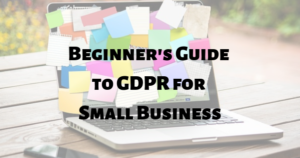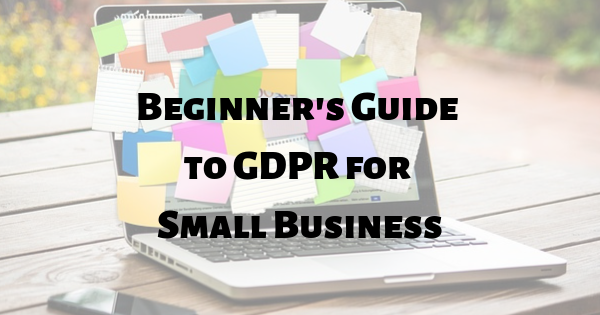Take full advantage of GDPR and use the regulations to your benefit as a small business rather than a hindrance to your website and/or corporate wellbeing.
 Whether you are a small business owner or a legalities expert in a startup, GDPR compliance plays a huge role in your continued development. The General Data Protection Regulation (GDPR) introduced by the EU in April of 2016 and only enacted in May of 2018 is an important piece of documentation which refers to any and all businesses with stakeholders in the European continent.
Whether you are a small business owner or a legalities expert in a startup, GDPR compliance plays a huge role in your continued development. The General Data Protection Regulation (GDPR) introduced by the EU in April of 2016 and only enacted in May of 2018 is an important piece of documentation which refers to any and all businesses with stakeholders in the European continent.
This means that GDPR implementation isn’t an option but a necessity, especially if you are a business based in North America or European region. However, the terminology, wording and statements within GDPR can be difficult to digest, especially for non-native English speakers. With that in mind, let’s break down how you can implement GDPR within your own small business in order to comply with the laws and regulations imposed by the EU.
What is GDPR anyway?
When all is said and done, GDPR isn’t as complex or groundbreaking as many would have you believe. In short, the data protection regulation became enforced as a response to the Facebook privacy debacle in March of 2018, which saw its CEO testify in front of a grand jury about the platform’s privacy policies the following month. The EU’s council decided to protect its citizens with GDPR as a means to counter large enterprises from private data exchange.
They have done this via a comprehensive data protection document which can and should be implemented by any business with active stakeholders on the European continent, regardless of its scale or target market. The implementation process itself, however, is left to individual businesses with the know-how of the digital landscape. Ask a lawyer if you don’t know how to deal with GDPR in terms of your existing documentation and policies.
So how do we abide by GDPR?
1. Review your privacy & cookie policies
Before diving into the GDPR compliance process itself, you should review the already-existing documents on your business’ website. Comparing your current documents with GDPR compliance templates will give you a better sense of whether or not you are close to full compliance with the regulation.
The finance and legalities specialist at PickWriters had this to say on the matter: ‘Businesses often panic before assessing their situation when it comes to GDPR. Practice has shown that many sites and e-commerce stores already abide by the majority of requirements posed by the EU which indicate a more seamless implementation than anticipated.’
2. Outline the implementation process
Review the GDPR compliance documents before moving on with any changes to your current documents, privacy policy and cookie requirements. The official GDPR documents reveal very precise directions which businesses should implement in their websites without leaving any small details out of the equation.
Once you compare the two, make sure to outline the implementation process on a step-by-step basis. Don’t modify live documents and/or any pages accessible to your customers before you have a presentable, GDPR-compliant policy to present. This will help you avoid any misunderstanding, public scrutiny or SEO problems due to your seemingly random changes in data management. Ask a lawyer about how to implement GDPR in the quickest and safest way, especially if you don’t have a privacy management expert in-house.
3. Eliminate unnecessary data
The most time-consuming aspect of GDPR compliance is the process of eliminating any unnecessary personal data you may or may not have in your backlog. Depending on the type of products and services you offer, you might have too much information on your customers than is necessary to conduct an exchange of goods. For example, do you really require phone numbers, personal addresses and employment information if you sell online services?
This level of information about your customers should be managed carefully in the wake of GDPR and kept to a controlled minimum from now on. Eliminate any unnecessary data from your servers and make sure to inform both your customers and any advertisers or B2B stakeholders who may have access to that information. After all, the point of the regulation is to protect the data of European citizens, so make sure to gauge data collection carefully going forward.
4.Introduce preemptive privacy compliance
One of the best ways to get in front of GDPR and the general paranoia surrounding data protection these days is to meet the problem head-on. Any visitor to your website should be greeted with a popup window stating that it is recommended that they visit the privacy policy page of your website before going further.
It’s also good practice to state outright that you do in fact comply with GDPR regulations on your site and that the details of said compliance are in the privacy and cookies section of your site. This will give your customers and clients a large sigh of relief given the reasoning behind GDPR and why the protection law was introduced in the first place.
5. Transparency about security
Speaking of transparency, it’s also a smart move to include any and all points of data which you collect or don’t collect in your privacy policy. Don’t be ambiguous about the type of information you will collect from now on, especially since GDPR favors sites which are upfront about their practices. This will also instill a level of confidence and trust in your site from potential customers, ensuring a higher level of engagement and conversion rates in the future.
Another note worth exploring is a section about the way you protect customer data on your site and servers. Explain the process of storing information and give a few tidbits of info about the kind of protection software and firewall you use to keep the data safe and secure. Ask a lawyer about the level of information you should and shouldn’t disclose to the public in regards to your data security systems. The more info you include about data security in your website’s policies, the more compliant with GDPR you will appear.
6. Offer a clear opt-out
Lastly, a good way to introduce GDPR compliance to your site in a quick fashion is to offer a clear and complete opt-out to your customers. In the wake of Facebook’s mismanagement of privacy and data, the company was forced to introduce a way out for anyone who might want to close their account and delete any and all personal data.
While you don’t have to apply this rule to all of your stakeholders, those who reside in the European region should have an ability to “wipe” their data from your site at a moment’s notice. This indivertibly makes it very difficult to sell or share customer data with advertisers or third-party retailers without explicit consent and knowledge from the consumers themselves. Ask a lawyer about the precautions you should take if you introduce an opt-out for your European stakeholders going forward. Be as forthcoming about your handling of private information and allow users to fully manage their data to the point of account and info deletion as required by the GDPR.
In summary
While the GDPR regulation isn’t going away, it is more than just a nuisance which you are forced to deal with. Comply with the requirements (which are reasonable and within the realm of legal possibility) and continue to operate your small business as usual. Use the regulation to your advantage in order to differentiate from your competitors and other sites in your industry.
- DIY Chicken Wire Jewelry Holder - June 27, 2022
- Jewelry Designer Manager Alternative - December 8, 2019
- 3 Tips To Immediately Boost Your Sales Today - May 12, 2019

